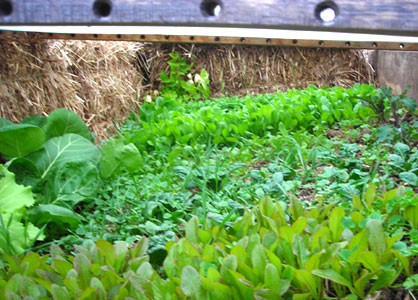Article by Ira Wallace, with Lisa Dermer
 Cold nights let us know fall is really here, along with the certainty that a killing frost will arrive any day. We’re enjoying bushels of broccoli along with the last outdoor beans, cucumbers, peppers and tomatoes. Beds of greens promise frost-touched sweetness for months to come.
Cold nights let us know fall is really here, along with the certainty that a killing frost will arrive any day. We’re enjoying bushels of broccoli along with the last outdoor beans, cucumbers, peppers and tomatoes. Beds of greens promise frost-touched sweetness for months to come.
For those who still haven’t made fall sowings of winter greens, it may not be too late. Last year we sowed greens under quickly put together cold frames on November 9, thinking they
would overwinter and be ready for early spring harvest. To our surprise, we were harvesting baby greens from those frames in late December and occasionally throughout the rest of winter. And when the weather warmed up in February, those plants took off well ahead of spring-sown greens.
My fastest growing fall-sown greens were arugula, cress, tatsoi, and kale. Baby lettuce seedlings transplanted from a crowded bed in the garden took off and grew quickly under row cover supported by hoops. We even harvested a last round of radishes from that November planting.
It’s best to avoid unrealistic expectations: last winter was unusually mild, and direct sown plantings made this late in the year may not reach harvestable size until early spring. Transplanting seedlings under protection in late fall gives a better guarantee of winter harvests. We’re transplanting crowded seedlings from the outdoor garden into cold frames or under row cover. A circle of gardening friends is also a great resource for extra fall seedlings, ready to be nestled into their cozy winter homes.
I hope you’ll take a chance on late fall sowings or transplants. Fresh winter harvesrts are one of the most important steps we can take towards food independence.
